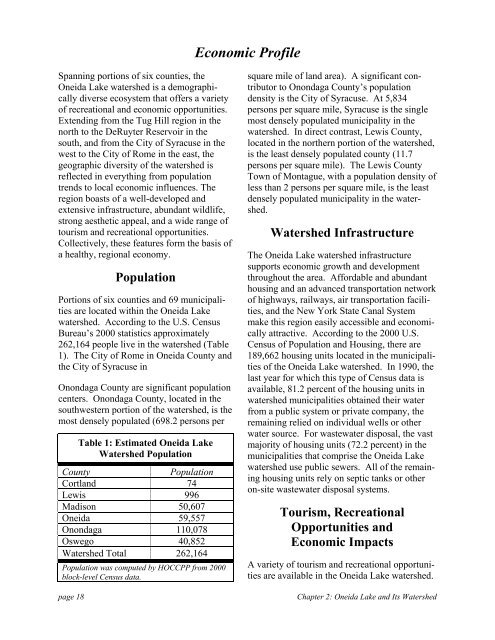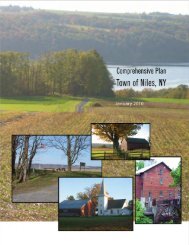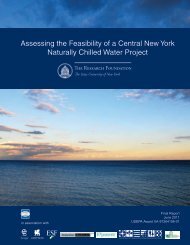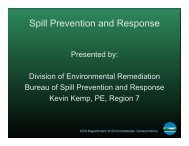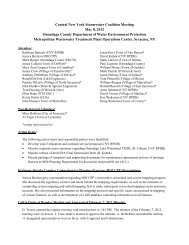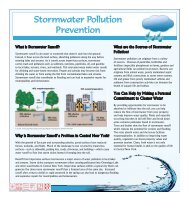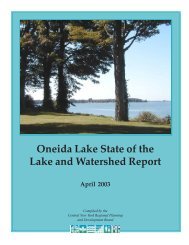A Management Strategy for Oneida Lake and its ... - CNY RPDB Home
A Management Strategy for Oneida Lake and its ... - CNY RPDB Home
A Management Strategy for Oneida Lake and its ... - CNY RPDB Home
Create successful ePaper yourself
Turn your PDF publications into a flip-book with our unique Google optimized e-Paper software.
Economic Profile<br />
Spanning portions of six counties, the<br />
<strong>Oneida</strong> <strong>Lake</strong> watershed is a demographically<br />
diverse ecosystem that offers a variety<br />
of recreational <strong>and</strong> economic opportunities.<br />
Extending from the Tug Hill region in the<br />
north to the DeRuyter Reservoir in the<br />
south, <strong>and</strong> from the City of Syracuse in the<br />
west to the City of Rome in the east, the<br />
geographic diversity of the watershed is<br />
reflected in everything from population<br />
trends to local economic influences. The<br />
region boasts of a well-developed <strong>and</strong><br />
extensive infrastructure, abundant wildlife,<br />
strong aesthetic appeal, <strong>and</strong> a wide range of<br />
tourism <strong>and</strong> recreational opportunities.<br />
Collectively, these features <strong>for</strong>m the basis of<br />
a healthy, regional economy.<br />
page 18<br />
Population<br />
Portions of six counties <strong>and</strong> 69 municipalities<br />
are located within the <strong>Oneida</strong> <strong>Lake</strong><br />
watershed. According to the U.S. Census<br />
Bureau’s 2000 statistics approximately<br />
262,164 people live in the watershed (Table<br />
1). The City of Rome in <strong>Oneida</strong> County <strong>and</strong><br />
the City of Syracuse in<br />
Onondaga County are significant population<br />
centers. Onondaga County, located in the<br />
southwestern portion of the watershed, is the<br />
most densely populated (698.2 persons per<br />
Table 1: Estimated <strong>Oneida</strong> <strong>Lake</strong><br />
Watershed Population<br />
County<br />
Population<br />
Cortl<strong>and</strong> 74<br />
Lewis 996<br />
Madison 50,607<br />
<strong>Oneida</strong> 59,557<br />
Onondaga 110,078<br />
Oswego 40,852<br />
Watershed Total 262,164<br />
Population was computed by HOCCPP from 2000<br />
block-level Census data.<br />
square mile of l<strong>and</strong> area). A significant contributor<br />
to Onondaga County’s population<br />
density is the City of Syracuse. At 5,834<br />
persons per square mile, Syracuse is the single<br />
most densely populated municipality in the<br />
watershed. In direct contrast, Lewis County,<br />
located in the northern portion of the watershed,<br />
is the least densely populated county (11.7<br />
persons per square mile). The Lewis County<br />
Town of Montague, with a population density of<br />
less than 2 persons per square mile, is the least<br />
densely populated municipality in the watershed.<br />
Watershed Infrastructure<br />
The <strong>Oneida</strong> <strong>Lake</strong> watershed infrastructure<br />
supports economic growth <strong>and</strong> development<br />
throughout the area. Af<strong>for</strong>dable <strong>and</strong> abundant<br />
housing <strong>and</strong> an advanced transportation network<br />
of highways, railways, air transportation facilities,<br />
<strong>and</strong> the New York State Canal System<br />
make this region easily accessible <strong>and</strong> economically<br />
attractive. According to the 2000 U.S.<br />
Census of Population <strong>and</strong> Housing, there are<br />
189,662 housing un<strong>its</strong> located in the municipalities<br />
of the <strong>Oneida</strong> <strong>Lake</strong> watershed. In 1990, the<br />
last year <strong>for</strong> which this type of Census data is<br />
available, 81.2 percent of the housing un<strong>its</strong> in<br />
watershed municipalities obtained their water<br />
from a public system or private company, the<br />
remaining relied on individual wells or other<br />
water source. For wastewater disposal, the vast<br />
majority of housing un<strong>its</strong> (72.2 percent) in the<br />
municipalities that comprise the <strong>Oneida</strong> <strong>Lake</strong><br />
watershed use public sewers. All of the remaining<br />
housing un<strong>its</strong> rely on septic tanks or other<br />
on-site wastewater disposal systems.<br />
Tourism, Recreational<br />
Opportunities <strong>and</strong><br />
Economic Impacts<br />
A variety of tourism <strong>and</strong> recreational opportunities<br />
are available in the <strong>Oneida</strong> <strong>Lake</strong> watershed.<br />
Chapter 2: <strong>Oneida</strong> <strong>Lake</strong> <strong>and</strong> Its Watershed


